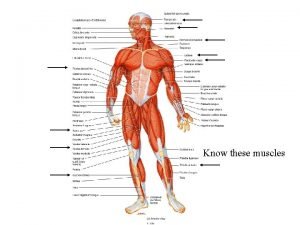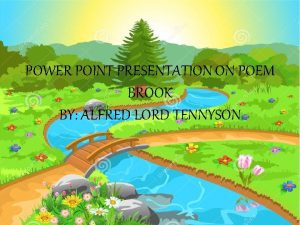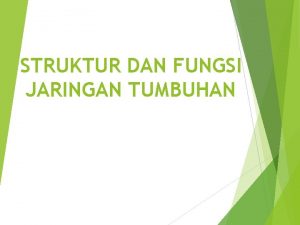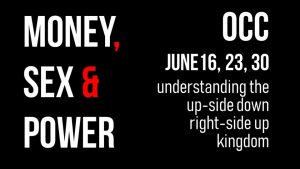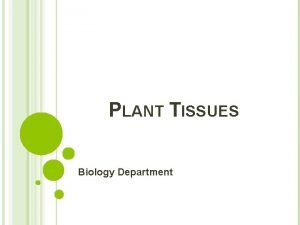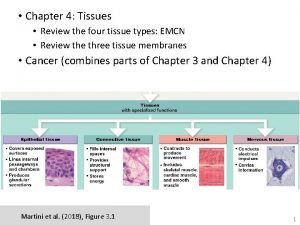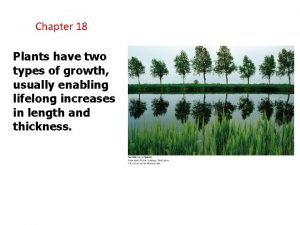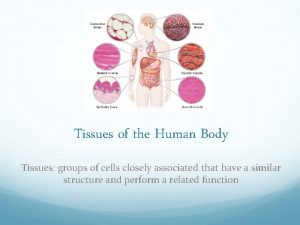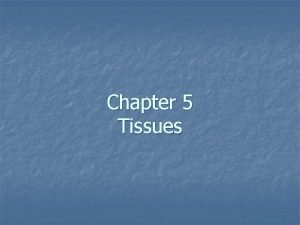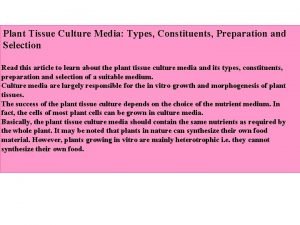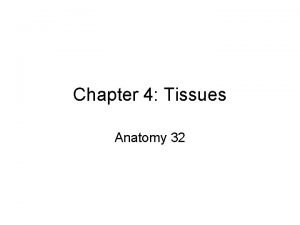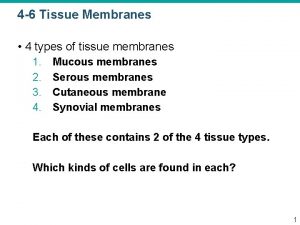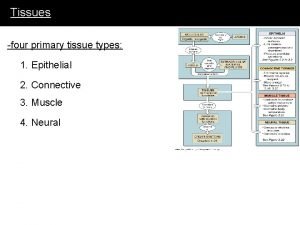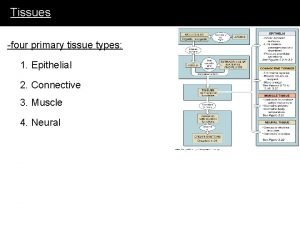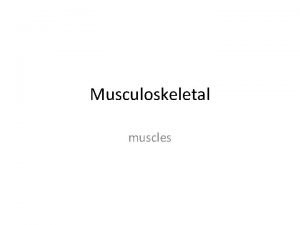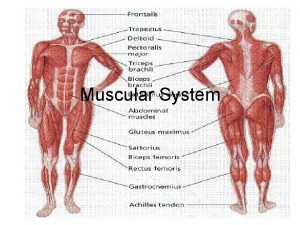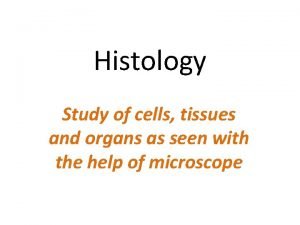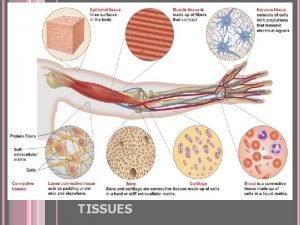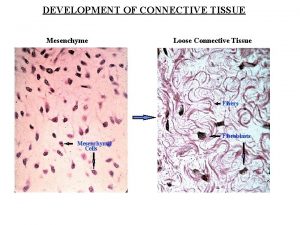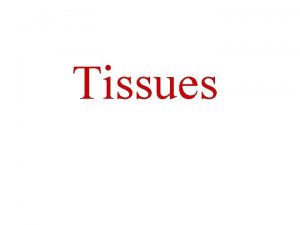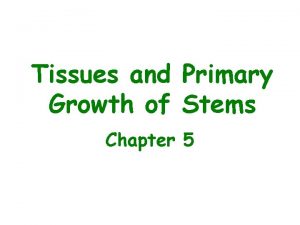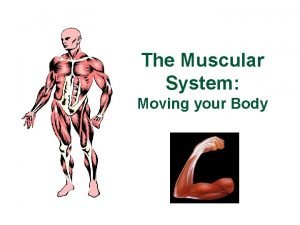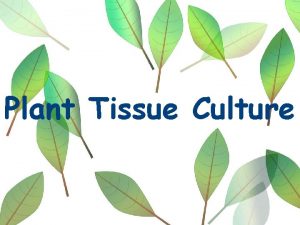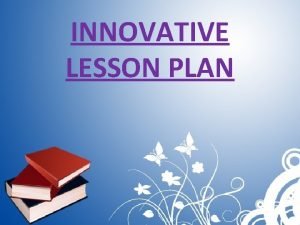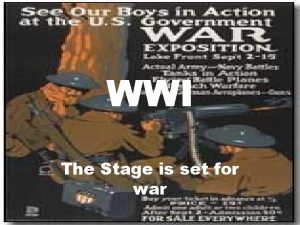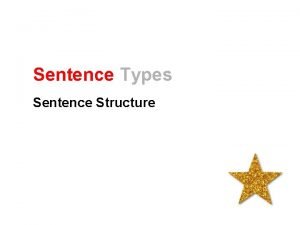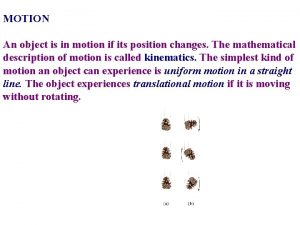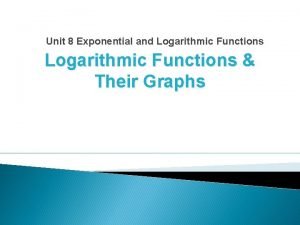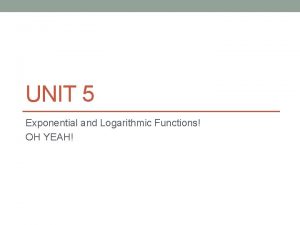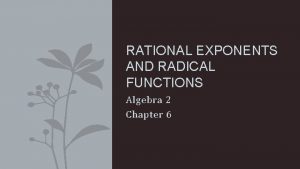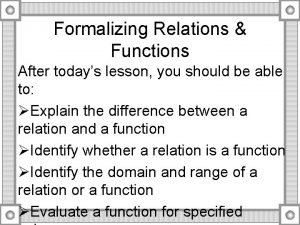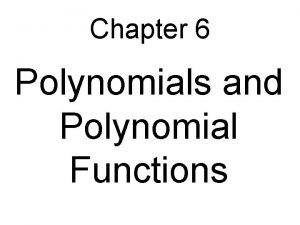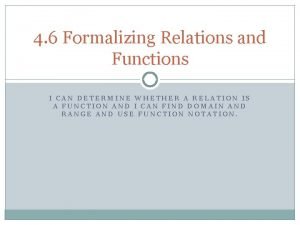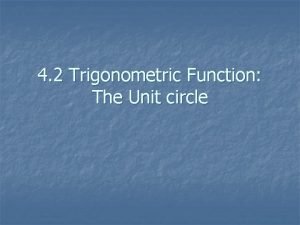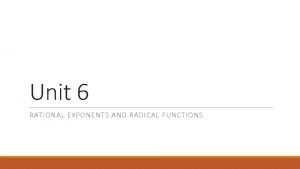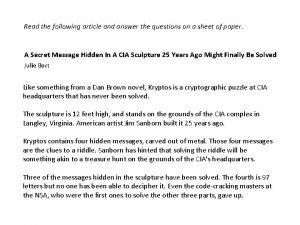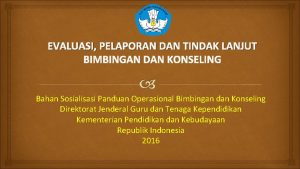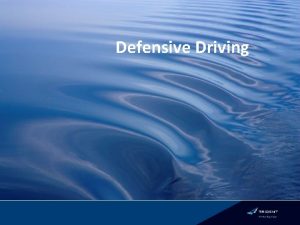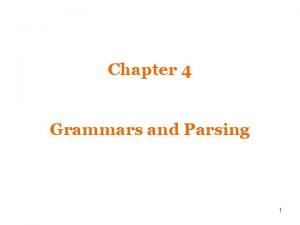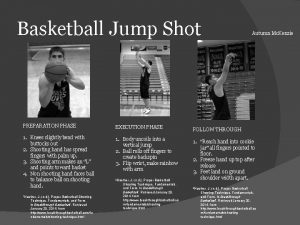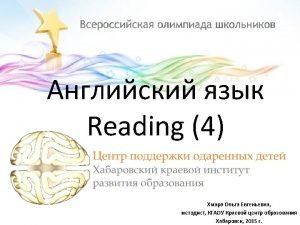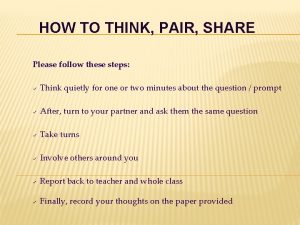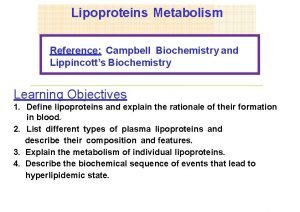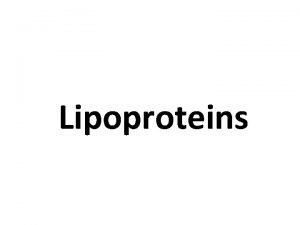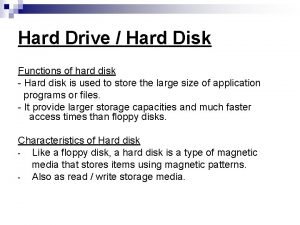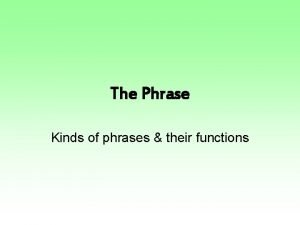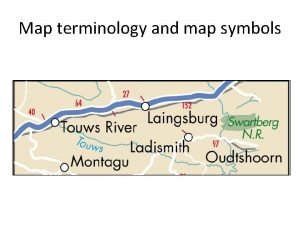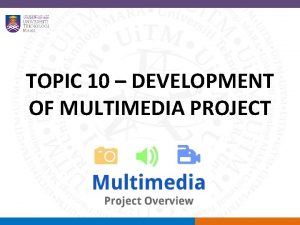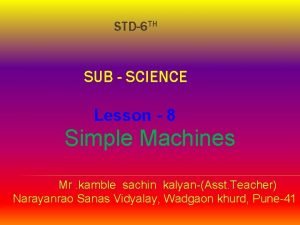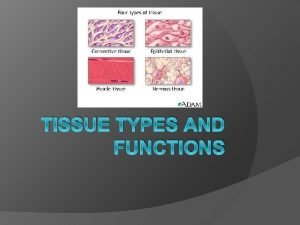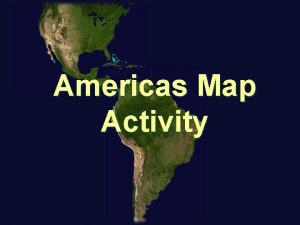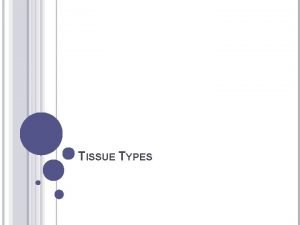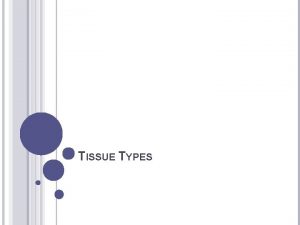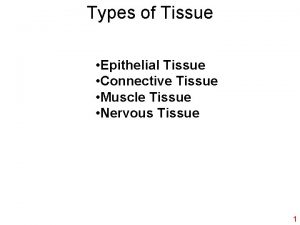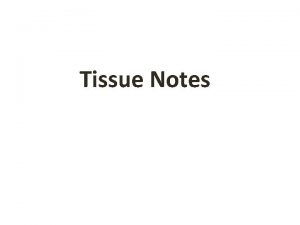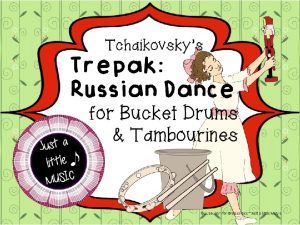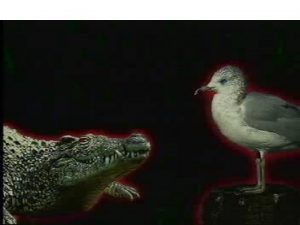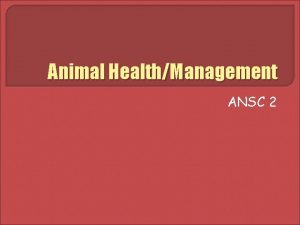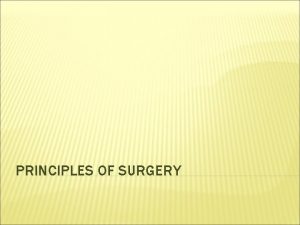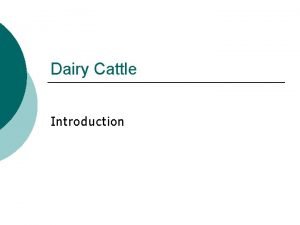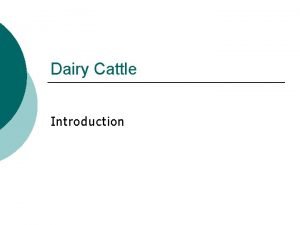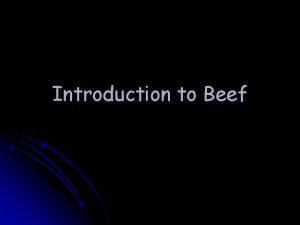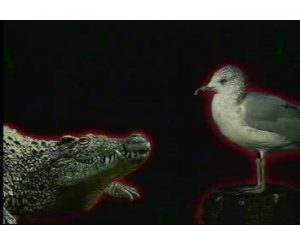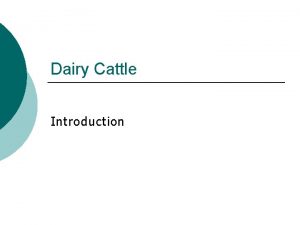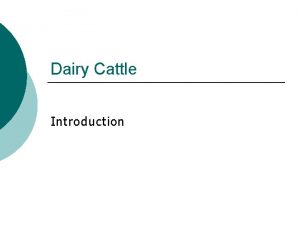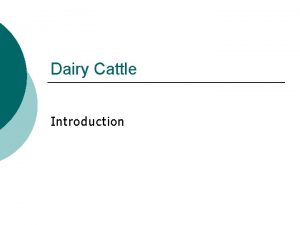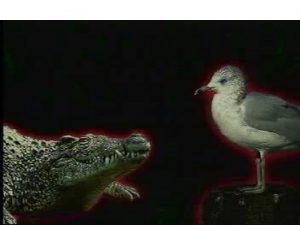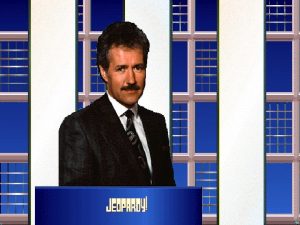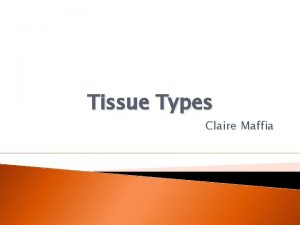TISSUE TYPES AND FUNCTIONS Unit Map Follow Along








































































- Slides: 72

TISSUE TYPES AND FUNCTIONS

Unit Map: Follow Along in your packet WHAT ARE YOU LEARNING? Describe tissue types and their functions Understand Explain tissue purpose

Know Understand Do! Know Tissue Types Tissue Locations Tissue Anatomy o o o Understand Do Tissue purposes in the Outline tissue functions body Tissue Represent properties tissue types Tissue Explain tissue development importance in animal health

Key Learning: Tissue Types and Functions Unit EQ: Why are tissues critical to animal health? Concept : Epithelial Concept : Lesson EQ: Connective/ Where is Muscle epithelial tissue Lesson EQ: located? How does Vocab connective Integument function? Keratin Vocab Tendon, Ligament Concept : Nerve Lesson EQ: Why is nerve tissue damage a serious injury? Vocab CNS, PNS

EPITHELIAL TISSUE

Essential Question Where is epithelial tissue located?

Warm Up What happened?

Epithelial Tissue Collections of cells packed together into layers Line body surfaces , openings, and tubes Intestinal, reproductive, and urinary tracts Blood vessels

Epithelial Functions Protection from outside environment Expulsion and movement of material within lumen tubes Secretory Absorption of specific material Conservation Sensory input

Protection From: Bacterial invasion Extreme temperatures UV radiation (damages cells) Drying out Trauma Cilia Specialized protrusions made from epithelial tissue. Tissues beat in a direction to help remove debris (lungs, coughing, move digesta through intestines)

Secretory Tears : protect eye tissue Saliva : begin digestion, moistens food Mucus: in airways, trap particles Mammary System: secrete milk (only in MAMMALS)

Absorption Highly Selective! Minerals Intestines, lungs, and kidneys Oxygen/CO 2 exchange Blood vessels Extracellular Fluid Is exchanged etc

Conservation ECF within cells is conserved

Sensory Input Retina: essential in transmitting visual input to CNS (central nervous system) Tongue: taste, touch and temperature Nose Ears

Histology: Epithelium Histology: study of cell structure in plants and animals ALL epithelial tissue have: Basement membrane: collection of fibers that tie epithelial to the underlying connective tissue No direct blood supply (underlying connective tissue supplies everything) Diffusion of nutrients and waste

Activity BREAK! Types of Epithelial Tissue Grab your coloring stuff! Please DRAW in your notes. They will be on your test.

Epithelial Tissue Categorized by: Layers ○ Simple: One layer ○ Stratified: multiple layers ○ Transitional: multiple layers that can change shape Shape ○ Squamous: flat ○ Cuboidal: Cube ○ Columnar: column All terms are combined ( Layer + Shape) to appropriately describe epithelium

What type if Where? Simple squamous (1 layer and flat) Found where there is a need for exchange. Very fragile. In protected areas. Large surface area for transfer ○ Line blood vessels: transfer of waste, fluids, nutrients, gases ○ Air sacs in the respiratory system: carbon dioxide and oxygen

What type is where? Simple Cuboidal (1 layer, square shaped) Associated with secretion or absorption (Exocrine and Endocrine) ○ Thyroid, pancreas, salivary glands ○ Tubules of the Kidney

Endo / Exo Explained Endocrine Cells Secrete hormones directly in to the blood stream for transport ○ Thyroid, adrenal, pituitary o. Exocrine o. Have ducts to transport their secretions to impact more local areas. Hormones do not enter blood stream o. Sweat and salivary glands

What type is where? Simple/ Stratified Columnar and Cuboidal (1+ layers of column or square) Nucleus near the base Associated with secretion and absorption ○ Stomach and many glands ○ Intestinal Lining Have microvilli <- fingerlike projection that drastically increase the surface area = more efficient absorption

What type is where? Stratified Squamous (many layers, flat) Found in areas of mechanical stress. Thickness determined by amount of stress to the area (back vs bottom of foot) ○ Rectum, Vagina, esophagus, mouth ○ SKIN!! = Integumentary System Originate from a basal layer ○ Appear more cuboidal Continually divide and move outward ○ Loose cytoplasm and nucleus becoming flatter and fluff off

Review Time! Epithelial Tissue review worksheet

CONNECTIVE TISSUE

Essential Question How does connective tissue function?

Warm Up

CONNECTIVE TISSUE Consists of two basic elements: Cells and Extra-cellular matrix

General Information Types and functions: Loose connective tissue: fat, areolar – insulation, protection Dense Connective: Ligaments and tendons – binding and support Cartilage – protection, support Bone - support Blood- transportation

Common Characteristics All Connective tissue share the following characteristics, despite the variety. Develop from the same embryonic tissue Composed of many different types of cells within the tissue. Contains extracellular matrix Great variation in the amount of blood supply (vascularization)

Extracellular Matrix Extracellular matrix is the substance that connective cells are embedded within. Made of nonliving material called ground substance. Can be liquid, gel-like, semi-solid or hard. Texture depends on amount of cell adhesion proteins: proteoglycans which trap water forming a gel. More proteins, more solid ground substance. Contains fibers that provide great strength, or flexibility, or both. Extracellular matrix allows Conn. Tissue to bear weight, mechanical abuse – protects!!

Fibers are embedded in ground substance to add strength/flexibility. Collagen: stronger than steel of the same size. STRENGTH! Elastic: allows tissue to stretch and recoil. FLEXIBLE! Reticular: delicate, forms nets that support free cells.


Cells in Matrix Cells in connective tissue make and maintain the ground substance and fibers. Each type of conn. Tissue have immature and mature forms of these cells. Immature cells have suffix “-blast” – actively produce matrix. Mature cells have suffix “-cyte” – maintain health of matrix, reverting to blasts to regenerate matrix after injury. Fibroblasts – make conn. Tissue/fibers Chondroblasts – make cartilage, Osteoblasts – make bone Hematopoeitic stem cells – make blood

TRUE CONNECTIVE TISSUE CELLS Fibroblasts: Secrete both fibers and ground substance of the matrix (wandering) Macrophages: Phagocytes that develop from Monocytes (wandering or fixed) Plasma Cells: Antibody secreting cells that develop from B Lymphocytes (wandering) Mast Cells: Produce histamine that help dilate small blood vessels in reaction to injury (wandering) Adipocytes: Fat cells that store triglycerides, support, protect and insulate (fixed)

MATRIX FIBERS Collagen Fibers: Large fibers made of the protein collagen and are typically the most abundant fibers. Promote tissue flexibility. Elastic Fibers: Intermediate fibers made of the protein elastin. Branching fibers that allow for stretch and recoil Reticular Fibers: Small delicate, branched fibers that have same chemical composition of collagen. Forms structural framework for organs such as spleen and lymph nodes.

TYPES OF CONNECTIVE TISSUE 1. True Connective Tissue a. Loose Connective Tissue b. Dense Connective Tissue 2. Supportive Connective Tissue a. Cartilage b. Bone 5. Liquid Connective Tissue a. Blood

Loose Connective Tissue Areolar – most widely distributed type. Serves as “packing material” cushioning organs, subcutaneous, attaches skin to muscle. Contains all three fibers Gelatinous Very loosely packed, lots of liquid Swells during inflammation (edema)

Loose Continued Adipose = Fat! Loosely packed with little matrix 90% of tissue is adipocytes Most of each cell is a fat droplet Nutrient storage, cushioning. Richly vascularized Develops within areolar tissue/subcutaneous ○ 18% of an average person’s weight ○ 50% of chubby person

Loose Continued Reticular Only contains reticular fibers. VERY DELICATE – a fine net of fibers. Supports free blood cells. Found in lymph nodes, bone marrow. REALLY TINY!

“Loose” connective tissues review Adipose tissue mostly under skin and in mesenteries Reticular: organized 3 -D network of fibers that support lots of cells E. g. marrow, spleen, lymph nodes

“Dense” Connective tissues Irregular Thick fibers running in many planes E. g. dermis, fibrous capsules around organs Regular Aligned parallel fibers Resists tension E. g. tendon, ligaments, aponeuroses Sometimes with elastic fibers (e. g. ligamentum nuchae)

Cartilage Characteristics Resists tension and pressure Tough and flexible No nerves or blood vessels Lots of collagen and elastic fibers, high content of proteoglycans. 80% water Chondroblasts make matrix until end of human adolescence. Mature Chondrocytes found in cavities called lacunae (pit)

Bone Most supportive tissue in body. Matrix is composed of collagen fibers surrounded by calcium salts. Osteoblasts make collagen fibers and calcium salts deposited between fibers. Well vascularized Osteocytes stored in lacunae Bone marrow stores fat and makes blood cells.

Connective Tissue Review Connective tissue review worksheet

MUSCLE TISSUE

Essential Question

Warm up

Functions Movement Posture maintenance Heat generation (3/4 of energy produced by ATP escapes as heat) Stabilization of joints Protection of some internal organs

Muscle Types Skeletal: striated, voluntary Cardiac: only in heart, striated, involuntary Smooth/Visceral: walls of organs, not striated, involuntary

Muscle types

Properties of Muscle Excitability: capacity of muscle to respond to a stimulus Contractility: ability of a muscle to shorten and generate pulling force Extensibility: muscle can be stretched back to its original length Elasticity: ability of muscle to recoil to original resting length after stretched

Skeletal muscle Attached to bones Makes up 40% of body weight Responsible for locomotion, facial expressions, posture, respiratory movements, other types of body movement Voluntary in action; controlled by somatic motor neurons

Basic Features of a Skeletal Muscle attachments Most skeletal muscles run from one bone to another One bone will move – other bone remains fixed ○ Origin – less movable attachment ○ Insertion – more movable attachment

Smooth Muscle In the walls of hollow organs, blood vessels, eye, glands, uterus, skin Some functions: propel urine, mix food in digestive tract, dilating/constricting pupils, regulating blood flow, In some locations, autorhythmic Controlled involuntarily by endocrine and autonomic nervous systems

Smooth Muscle Cells are not striated Fibers smaller than those in skeletal muscle Spindle-shaped; single, central nucleus More actin than myosin No sarcomeres Not arranged as symmetrically as in skeletal muscle, thus NO striations. Caveolae: indentations in sarcolemma; May act like T tubules Dense bodies instead of Z disks Have noncontractile intermediate filaments

Smooth Muscle • Grouped into sheets in walls of hollow organs • Longitudinal layer – muscle fibers run parallel to organ’s long axis • Circular layer – muscle fibers run around circumference of the organ • Both layers participate in peristalsis Figure 9. 24

Cardiac muscle Heart: major source of movement of blood Autorhythmic Controlled involuntarily by endocrine and autonomic nervous systems

Cardiac Muscle Found only in heart where it forms a thick layer called the myocardium Striated fibers that branch Each cell usually has one centrally-located nucleus Fibers joined by intercalated disks IDs are composites of desmosomes and gap junctions Allow excitation in one fiber to spread quickly to adjoining fibers Under control of the ANS (involuntary) and endocrine system (hormones) Some cells are autorhythmic Fibers spontaneously contract (aka Pacemaker cells)

Cardiac Muscle Tissue Figure 10. 10 a

Neuromuscular Junction Region where the motor neuron stimulates the muscle fiber The neuromuscular junction is formed by : 1. End of motor neuron axon (axon terminal) ○ Terminals have small membranous sacs (synaptic vesicles) that contain the neurotransmitter acetylcholine (ACh) 2. The motor end plate of a muscle • A specific part of the sarcolemma that contains ACh receptors Though exceedingly close, axonal ends and muscle fibers are always separated by a space called the synaptic cleft

Neuromuscular Junction Figure 9. 7 (a-c)

Muscle Quiz! Fill in the graphic organizer below: Muscle Heart Intestines Stomach Wall Bicep Ham String Type of Movement Striated or Unstriated

Key Muscle Type of Movement Striated or Nonstriated Heart involuntary striated Intestines Involuntary nonstriated Stomach Wall involuntary Nonstriated Bicep Voluntary Striated Ham String Voluntary Straited

NERVE TISSUE

Essential Question Why is nerve tissue damage a serious injury?

Warm Up

Over view Allow for communication between and among parts of the body Found in: Brain+ spinal chord= CNS Peripheral nervous = PNS

Nerve tissue = Neurons have Dendrites- impulses received from other cells at synapses are transmitted to the cell body Nucleus- “brain” Neuron soma- Cell Body contains nucleus Axon- conducts electrical impulses away from the neuron's soma

Nerve Attachments Synapses- connection between 2 neurons On Tissues Muscle

Nerve Impulse occurs as a flow of ions passes through the cell membrane Resting neuron: Sodium ions actively transported into ECF (OUT). Potassium pumped into cytoplasm (IN)

Nerve Project Choose an animal 2. Outline its movement of all limbs (fore and hind limbs) for one full “step” (all four limbs MOVE in one step of an animal gait) 3. Outline the impulse pathway that requires ONE limb to MOVE 4. Draw a representation of the nerve impulse pathway 1.

Types of Neurons Sensory: have receptors that react to changes in the animal’s environment Light, heat, Touch/Pressure, Hearing, Balance, Taste, Smell, Internal Chemical (results in thirst)
 Wherever you lead i will follow
Wherever you lead i will follow How is aerolar tissue different than aerenchyma tissue?
How is aerolar tissue different than aerenchyma tissue? Unit 10, unit 10 review tests, unit 10 general test
Unit 10, unit 10 review tests, unit 10 general test Adipose connective tissue functions
Adipose connective tissue functions Thin
Thin Foamy flake
Foamy flake Gambar peta konsep jaringan tumbuhan
Gambar peta konsep jaringan tumbuhan Matthew mark luke john acts romans song
Matthew mark luke john acts romans song I can evaluate functions
I can evaluate functions Evaluating functions and operations on functions
Evaluating functions and operations on functions Tissue meaning in biology
Tissue meaning in biology Ground tissue definition
Ground tissue definition Connective tissue quiz
Connective tissue quiz What are the primary tissue types
What are the primary tissue types 4 body tissues
4 body tissues Dermal tissue types
Dermal tissue types Http://www.biologycorner.com/anatomy/histology/
Http://www.biologycorner.com/anatomy/histology/ Four principal types of tissue
Four principal types of tissue Tissue culture media types
Tissue culture media types Blood tissue types
Blood tissue types 4 types of tissue membranes
4 types of tissue membranes What are the four primary tissue types
What are the four primary tissue types Types of exocrine glands
Types of exocrine glands Axial muscles
Axial muscles Types of muscle
Types of muscle Zonula occludens histology
Zonula occludens histology Haematology consultants sheffield
Haematology consultants sheffield Epithelial tissue
Epithelial tissue Dense regular connective
Dense regular connective Four major tissue types
Four major tissue types Xylem in stem
Xylem in stem Skeletal muscle location
Skeletal muscle location Callus culture definition
Callus culture definition Four basic types of animal tissue
Four basic types of animal tissue Lumping along with man and load meaning
Lumping along with man and load meaning A shot rings throughout europe
A shot rings throughout europe Whats a simple sentence
Whats a simple sentence An object travels back and forth along a straight line
An object travels back and forth along a straight line Name for work or effort being put into a mechanism.
Name for work or effort being put into a mechanism. Unit 8 exponential and logarithmic functions
Unit 8 exponential and logarithmic functions Exponential and logarithmic functions unit test
Exponential and logarithmic functions unit test Horizontal asymptotes rules
Horizontal asymptotes rules Radical functions and rational exponents unit test
Radical functions and rational exponents unit test Lesson 4-6 formalizing relations and functions answers
Lesson 4-6 formalizing relations and functions answers End behavior of a function chart
End behavior of a function chart Formalizing relations and functions
Formalizing relations and functions Unit circle
Unit circle Unit 6 test radical functions
Unit 6 test radical functions Look at the following pictures and answer the questions
Look at the following pictures and answer the questions Service and follow up for customer retention
Service and follow up for customer retention Read the article and answer the questions.
Read the article and answer the questions. Tindak lanjut konseling
Tindak lanjut konseling Follow the four r's read right reduce and ride when
Follow the four r's read right reduce and ride when Find first and follow of grammar
Find first and follow of grammar National mechanisms for reporting and follow-up
National mechanisms for reporting and follow-up Phase 1 basketball
Phase 1 basketball Read the text and answer the questions.
Read the text and answer the questions. Read the text. answer the questions
Read the text. answer the questions Please follow and share
Please follow and share Absolute value of x as a piecewise function
Absolute value of x as a piecewise function Types of lipoprotein and their functions
Types of lipoprotein and their functions Types of lipoprotein and their functions
Types of lipoprotein and their functions Main function of the hard disk
Main function of the hard disk Utility program types
Utility program types Phrases and their functions
Phrases and their functions Map symbols and meanings
Map symbols and meanings Two different contour lines cannot cross because
Two different contour lines cannot cross because Unit 4 lesson 7 right triangles and trigonometry unit test
Unit 4 lesson 7 right triangles and trigonometry unit test Unit process and unit operation
Unit process and unit operation Difference between unit process and unit operation
Difference between unit process and unit operation Multimedia project development
Multimedia project development Along inclined plane wrapped around a shaft
Along inclined plane wrapped around a shaft Position vector simple definition
Position vector simple definition




